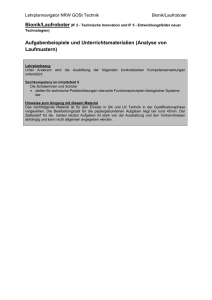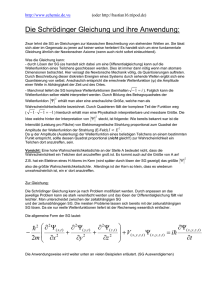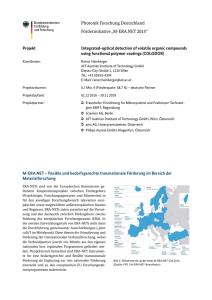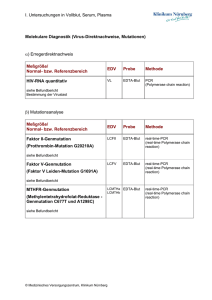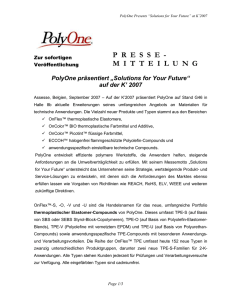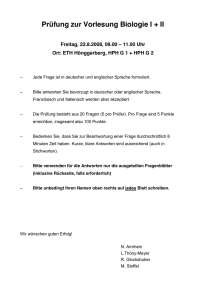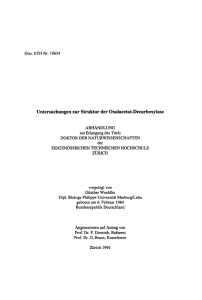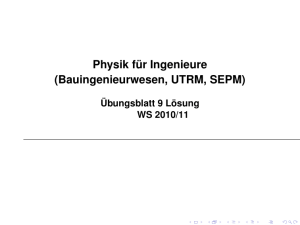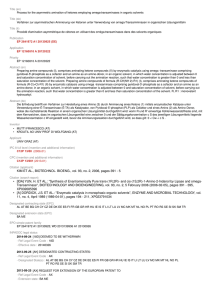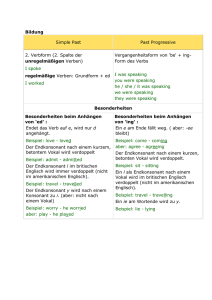lk^.^tA>>^~0p - ETH E
Werbung
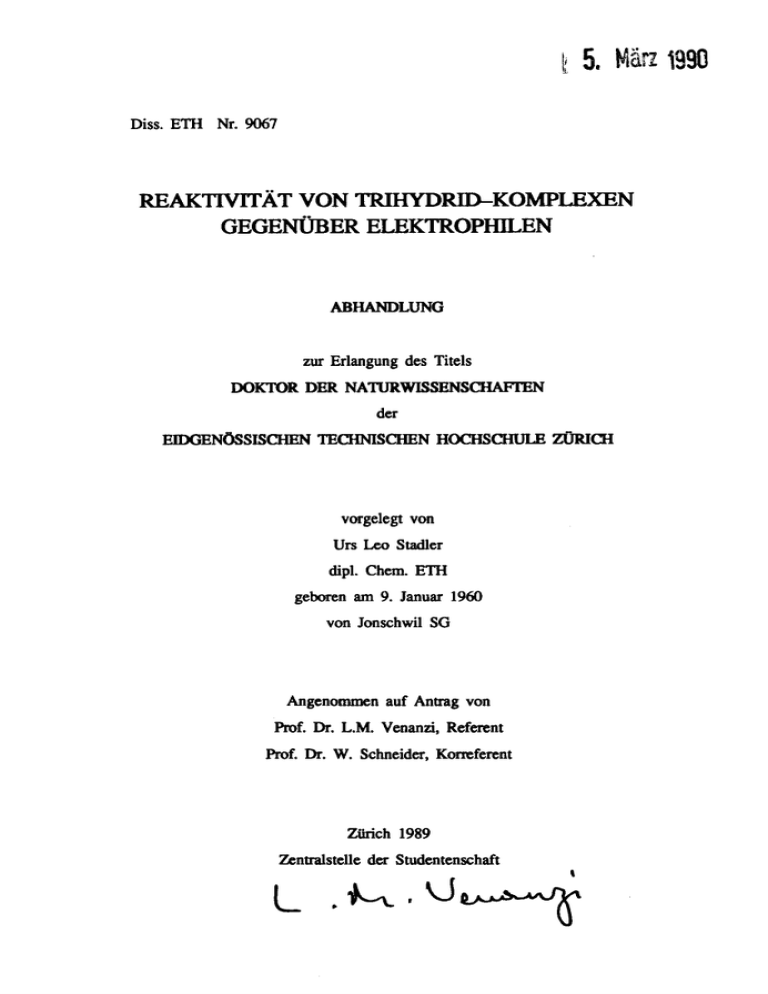
fc
Diss. ETH
5. März 1890
Nr. 9067
REAKTIVITÄT VON TRIHYDRID-KOMPLEXEN
GEGENÜBER
ELEKTROPHILEN
ABHANDLUNG
zur
Erlangung
des Titels
DOKTOR DER NATURWISSENSCHAFTEN
der
EIDGENÖSSISCHEN TECHNISCHEN HOCHSCHULE ZÜRICH
vorgelegt
von
Urs Leo Stadler
dipl.
geboren
Chem. ETH
am
von
9. Januar 1960
Jonschwil SG
Angenommen
auf
Antrag
von
Prof. Dr. L.M. Venanä, Referent
Prof. Dr. W. Schneider, Korreferent
Zürich 1989
Zentralstelle der Studentenschaft
|^_
>lk^.^tA>>^~0p
Zusammenfassung
Der
(M
[MH3(tripod)]
über
dieser Arbeit
Gegenstand
Ir, Rh
=
die Reaktivität
war
tripod
;
Die dabei erhaltenen Produkte wurden
Elektrophilen.
Im ersten Teil wurde die Reaktion dieser
klassischer
eine
jedem
In
Fall
über
von
Säure führte dies
an
entstand
mit
ein
Im
stabil
Anwesenheit
Fall
von
zwei
Zusammensetzung
eingesetzt,
Säure
Iridium
von
die
war
weiteren
[Rl^H^triphos)^
untersucht. Die
der
11
setzung
im
dem
Verbindungen
der
der
12
Gruppe
nicht¬
Wasserstoff in eine
Säure dimerisierte dann diese
einer
zu
Verbindung
der
2:1
(M
Verhältnis
1:1
Zusammensetzung
ergab
[{MH3(tripod)}2Cd]2+.
sich
in
so
entstanden
Bei
Rhodium
[RhH2(triphos)]+
zu
unterschiedliche
[I^HjOriphos)^"1"
als
einer
Metallzentrum
Verbindung
der
.
Umsetzung
Verhältnis
[{MH3(tripod)}2M']+
mit
von
gebildete Verbindung
Protonen.
ungesättigte Spezies
d^-Zentren
Reaktion
Entwicklung
Aequivalent
Im zweiten Teil wurde die Reaktivität
Gruppe
ein
welcher beim Aufwärmen auf
Trihydrid [MH3(tripod)]
Aequivalent
Produkte.
dimerisierten
dem
zuerst
binuklearen
[M2H5(tripod)2]+-
Zusammensetzung
in
Temperatur
von
der
überging.
Bei der Reaktion mit einem halben
ungesättigte Spezies
Abhängigkeit
In
einer Reihe
zu
tiefer
bei
20 °C unter
-
[MH2(tripod)]+
ungesättigte Spezies
Wurde
Typs
mit Protonen im nicht
untersucht.
[MH2(il2-H2)(tripod)]+,
Hydrid-Komplex
Temperatur
des
P, As) gegen¬
=
allem durch IR- und
vor
Trihydride
Methylenchlorid
Lösungsimttel
eingesetzten Aequivalente
Verbindungen.
E
;
charakterisiert
NMR-Spektroskopie
koordinierenden
Trihydriden
von
CH3C(CH2EPh2)3
=
[MH3(tripod)] gegenüber 'nackten'
Trihydride mit 'nackten' d^-Zentren
von
der
ergab Addukt-Verbindungen
=
Cu(I),
Ag(I),
durchgeführt,
so
Au(I)).
beiden
Fällen
nur
Wurde
entstanden
[{MH3(tripod)}3M'3p+.
die
der Zusammen¬
Mit
die
trimere
gleiche
Cluster-
Cadmium(II)
trinukleare
aus
Verbindung
In allen
der erhaltenen
NMR-Spektren
Addukte
[MH3(tripod)]-Einheiten dynamisch bezüglich
Aufgrund
der
trinuklearen
für die
konnte
IR-Spektren
wurde
und
Kupfer-
[(tripod)HM(n-H)2M'(!d-fl)2MH(tripod)]+
(M'
Dies wurde durch die Kristallstrukturen der
bestätigt
die
FUr
Absorptionsbanden
der
lagen,
Da keine
waren.
kann keine definitive
Für die trimeren
Ag(I),
der Kristallstruktur
von
sechs
in
Metallatome
dlu-Zentren
Aussage
nur
analoge
Struktur
Ebene
einer
zur
L
=
d^-JT-agmenten
mono-, bis- oder tridentater
klassischen
der
postuliert
und die
konnte bei den
edrischen
stätigte
die
des
jeweiligen
d* -Fragmente
sind.
NMR-aktiven
konstanten
legte
(M'
Trotzdem
Metallzentren
In den
wiederum
konnten
erhalten.
jeweiligen
mit elektro¬
Ag(I),
Cd(II)
;
Addukt-Verbindungen
Aufgrund
der
IR-Spektren
eine statische Struktur mit einer tetra-
zum
NMR-Spektren
dynamisch
vor
die
bei.
Cu(I),
=
Beispiel
untersucht. Dabei wurden in einer
Trihydrids [MH3(tripod)]
dreizähniger Ligand'.
Einheiten
Verbindungen
Cu(I),
liegen
den
zwischen
=
am
Kupfer-Zentrums postuliert werden.
des
zwei- oder
(M'
Dabei
war.
die heterometallischen
Kupfer-Komplexen jeweils
Analogie
bekannt
vor¬
werden.
gemacht
Trihydride [MH3(tripod)]
Phosphinligand)
[(tripod)MH3M'(L)]z+
Koordinationsspäre
nur
Hydrid-
Komplexe
werden, wie sie
Bindungen
[M'(L)]Z+
"Donor-Akzeptor-Reaktion'
Zusammensetzung
dieser
[{MH3(tripod)}3M'3]3+
Stabilität dieser
Typ
vom
IR-Spektrum
verbrückenden
von
Röntgenstrukturanalysen
Im dritten Teil wurde die Reaktion der
philen
solche
[{RhH3(triphos)}3Ag3]3+
tragen wesentlich
im
wurden
über eine statische Struktur
Cluster-Verbindungen
Au(I)) konnte eine
Ag(I)) postuliert
Typ
werden.
Hydrid-Liganden beobachtet, während im Fall
terminalen
entsprechenden Cadmium-Komplexe
Liganden erkennbar
vom
jeweiligen Rhodium-triphos-Komplexe
Gold-Verbindungen
analogen
von
Cu(I),
die
sind.
Silber-Ver¬
bindungen eine statische Struktur mit zwei terminalen Hydrid-Liganden
=
dass
festgestellt,
jeweiligen d^-Zentrums
des
allem
Tetrahydroborat
wurde
bezüglich
bei
(Rh, Ag, Cd) aufgrund
den
Dies
festgestellt,
der
als ein-,
dass die
[MH3(tripod)]-
Verbindungen mit
der Grösse
be¬
von
den
Kopplungs¬
Aussagen über die Bindungsverhältnisse gemacht weiden. Insbesondere
die in einem Fall bestimmte
dass in diesen heterometallischen
Kopplung
/(^Ag.^Rh)
Verbindungen
zwischen den beiden Metallzentren besteht.
eine
<ne
Vermutung nahe,
signifikante Wechselwirkung
Abstract
The
of
topic
[MH3(tripod)] (M
Ir, Rh
The
electrophiles.
thesis
this
=
is
tripod
;
the
=
obtained
products
trihydrides of the
of
reactivity
CH3C(CH2EPh2)3
were
E
;
=
P, As) towards
characterized
mainly
type
IR-
by
and
NMR-spectroscopy.
The
first
part
methylenechloride,
first
lost
hydrogen
saturated
a
non-classical
a
species
series of binuclear
hydride-complex
warming
upon
[MH2(tripod)]+,
The reaction of half
this unsaturated
was
species
composition
Different
In the
with
trihydrides
solvent.
Depending
Compounds
were
which gave different
-
protons
cases
formed, which
was
20 °C,
in
the stoichio¬
on
obtained. In all
[MH2(T|2--H2)(tripod)]+
temperature above
equivalent of
an
giving
to an un¬
products depending
on
the
species
acid with
of
trihydride,
to a
Compound
equivalent
one
trihydride [MH3(tripod)]
[M2Hj(tripod)2]+-
products
obtained upon reaction with
were
Compound
stable in the presence of
saturated
a
dimerized with the
of iridium the
case
up to
these
of the reaction.
stoichiometry
of the
of
typical non-coordinating
a
metry of acid added,
at
reaction
the
reports
[h^H^triphos^"*",
excess
[RhH2(triphos)]+
protons. In the
dimerized to
a
one
which
case
equivalent
of acid.
immediately formed,
of rhodium
Compound
of the
two
un¬
composition
[Rh2H4(triphos)2]2+.
The
second
[MH3(tripod)] towards
d1 "-centers of group
complexes
of the
Hexanuclear
of
part
'naked'
11
cluster-compounds
Compound
a
was
d^-centers.
the
composition
obtained upon reaction in
trinuclear
in
work
the
ratio
2:1
concerned
with
The reaction of
resulted
in
the
reactivity
trihydrides
the
formation
with 'naked'
of adduct-
[{MH3(tripod)}2M']+
(M'
of the
[{MH3(tripod)}3M'3]3+
composition
ratio of 1:1. With
[{MH3(tripod))2Cd]2+
was
=
of
Cu(I), Ag(I), Au(I)).
were
cadmium(II) the formation of the
observed in both
cases.
The
of
characterization
of
behaviour
dynamic
d^-center.
structural
the
jn
having
trinuclear
X-ray
an
complexes. Absorptions assignable
IR-spectra
of the
four
(M'
determination
structure
relative
of
only
to
=
bridging
terminal
hydrides
in the
X-ray diffraction studies prevented definitive structural
The
static
found
structure
by
[{RhH3(triphos)]3Ag3]3+ could also be
compounds [{MH3(tripod)}3M'3]3+ (M'
Cu(I), Ag(I),
=
complex
contains six metal-atoms
ding d^-centers
appears
The reaction of the
of the type
[M'(L)]Z+
phosphine ligand)
was
[(tripod)MH3M'(L)]z+
static structure with
deduced
from
coordination
these
the
to
the
mation about the
centers
obtained
one
by
as
a
a
the
of
bis-
dynamic
;
L
sphere
copper
trihydrides
mono-,
with
classical
a
tetrahedral coordination
[MH3(tripod)]-units.
Compounds containing
determined in
were
in these heterometallic
for
the
a
of these
or
correspon¬
Compounds.
d'"-firagments
mono-, bis-
Compounds.
[MH3(tripod)]
tridentate
cluster-
silver-complex
electrophilic
=
complex
analogous
the
or
tridentate
composition
A
for the copper atom could be
This
and the
ligand'.
behaviour of the
The
confirmed
the
tetrahydroborate
NMR-spectra
corresponding
of
d^-fragments
Furthermore, the value of the couplings in
Situation. The
case, indicated
The lack of
'donor-acceptor-reaction'.
NMR-active metal-centres (Rh,
bonding
IR-spectra.
heterometallic adducts of the
investigated. Thus,
showed
complexes
Cu(I), Ag(I), Cd(II)
=
type
of the cadmium-
Au(I)). The
stability
trihydrides [MH3(tripod)]
(M'
between the
aet
can
for the
the
confirmed
observed in the
were
coplanar and the bonding between the
important
IR-spectra
analogy
anion which
relative
a
be
to
of
was
assignments.
for
postulated
a
rhodium-triphos-
case
analysis
X-ray
silver,
static structural
hydrides
whereas in the
a
corresponding
a
corresponding
recognized
were
with
showed
and
Cu(I), Ag©). This
the
analogous gold-compounds,
complexes only bridging hydrides
the
to
of copper
Compounds
and
[(tripod)HM(n-H)2M'(n-H)2MH(tripod)]+
by
NMR-spectroscopy
postulated by IR-spectroscopy
terminal
two
by
[MH3(tripod)]-units
of the
could be
assignment
conformation
the
case
adducts
these
coupling
Ag, Cd)
gave
J(,"^Agy*"Rh),
infor¬
which could be
significant interaction between the
Compounds.
some
two
metal-

